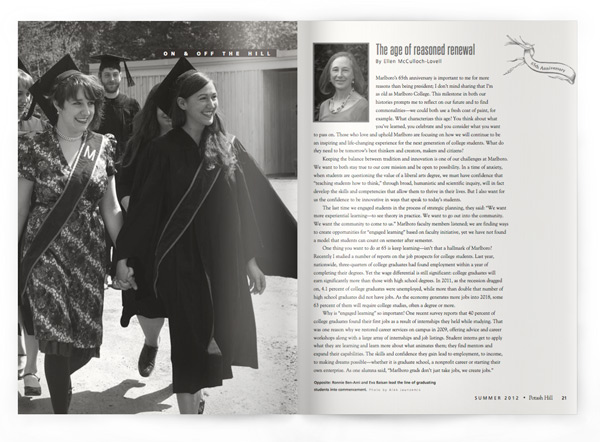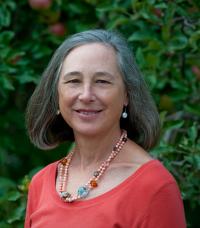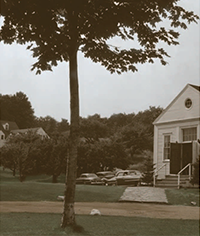
By Ellen McCulloch-Lovell
 Marlboro’s 65th anniversary is important to me for more reasons than being president; I don’t mind sharing that I’m as old as Marlboro College. This milestone in both our histories prompts me to reflect on our future and to find commonalities—we could both use a fresh coat of paint, for example. What characterizes this age? You think about what you’ve learned, you celebrate and you consider what you want to pass on. Those who love and uphold Marlboro are focusing on how we will continue to be an inspiring and life-changing experience for the next generation of college students. What do they need to be tomorrow’s best thinkers and creators, makers and citizens?
Marlboro’s 65th anniversary is important to me for more reasons than being president; I don’t mind sharing that I’m as old as Marlboro College. This milestone in both our histories prompts me to reflect on our future and to find commonalities—we could both use a fresh coat of paint, for example. What characterizes this age? You think about what you’ve learned, you celebrate and you consider what you want to pass on. Those who love and uphold Marlboro are focusing on how we will continue to be an inspiring and life-changing experience for the next generation of college students. What do they need to be tomorrow’s best thinkers and creators, makers and citizens?
Keeping the balance between tradition and innovation is one of our challenges at Marlboro. We want to both stay true to our core mission and be open to possibility. In a time of anxiety, when students are questioning the value of a liberal arts degree, we must have confidence that “teaching students how to think,” through broad, humanistic and scientific inquiry, will in fact develop the skills and competencies that allow them to thrive in their lives. But I also want for us the confidence to be innovative in ways that speak to today’s students.
The last time we engaged students in the process of strategic planning, they said: “We want more experiential learning—to see theory in practice. We want to go out into the community. We want the community to come to us.” Marlboro faculty members listened; we are finding ways to create opportunities for “engaged learning” based on faculty initiative, yet we have not found a model that students can count on semester after semester.
One thing you want to do at 65 is keep learning—isn’t that a hallmark of Marlboro? Recently I studied a number of reports on the job prospects for college students. Last year, nationwide, three-quarters of college graduates had found employment within a year of completing their degrees. Yet the wage differential is still significant: college graduates will earn significantly more than those with high school degrees. In 2011, as the recession dragged on, 4.1 percent of college graduates were unemployed, while more than double that number of high school graduates did not have jobs. As the economy generates more jobs into 2018, some 63 percent of them will require college studies, often a degree or more.
Why is “engaged learning” so important? One recent survey reports that 40 percent of college graduates found their first jobs as a result of internships they held while studying. That was one reason why we restored career services on campus in 2009, offering advice and career workshops along with a large array of internships and job listings. Student interns get to apply what they are learning and learn more about what animates them; they find mentors and expand their capabilities. The skills and confidence they gain lead to employment, to income, to making dreams possible—whether it is graduate school, a nonprofit career or starting their own enterprise. As one alumna said, “Marlboro grads don’t just take jobs, we create jobs.”
Day to day at the college, I’m very moved and affected by the transition in the faculty that we’re continuing to see at quite a rapid pace. Revered, honored, long-serving faculty are retiring each year, and that makes us sad. Yet there is also excitement that comes when someone new arrives, embraces the place and says, “I found my home.” A profound question for us, as it is for anyone who grows older, is how do you honor the past even while being open to new ideas? We must respect and build on the work of those who upheld this institution for years, making it what it is today. At the same time, when we invite new faculty here, we are saying, “Come to Marlboro and give us all your gifts.”
Marlboro is a fundamentally creative place. Although I’ve worked for years in the arts, I’ve never experienced an atmosphere where so much creativity occurs so abundantly that we don’t even name it. Creativity thrives by allowing the “widest and freest ranging of the human mind” according to Brewster Ghiselin in his 1952 book, The Creative Process . But to complete this process, “what is needed is control and direction.” The creative process is stimulated when previously disparate elements are related, similar to what happens here in interdisciplinary studies and team teaching.
I believe that creativity is a part of the fabric of Marlboro, starting with the veterans who came and slept under the apple trees while they made an old farmhouse into a dorm. It’s a habit of mind and a habit of making that happens in the faculty-student interactions and is also encouraged outside the classroom, studio and laboratory. It is also inspired by our being in a beautiful place. You gain a sense of both sanctuary and possibility here—a haven for learning, a haven for becoming. It gives me great hope that Marlboro has the creativity to evolve and renew itself to meet the needs of future students.
At 65 years old you step back—you assess. You say, “What do I want to do next? I don’t want to just repeat myself.” Similarly, I think institutions have to be very conscious of where they are headed. I want new stories for myself, and I feel the same way about Marlboro. We’ve got a great story, one that needs to be continually renewed and told.

